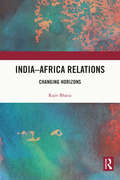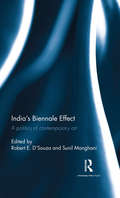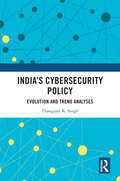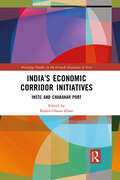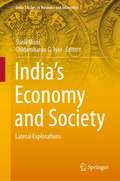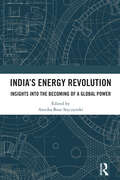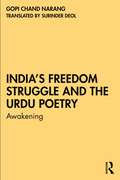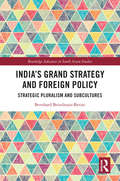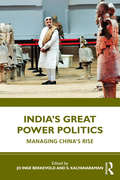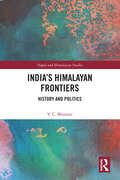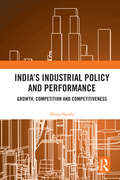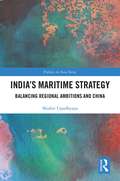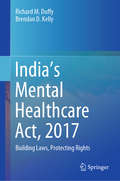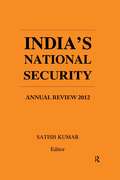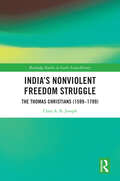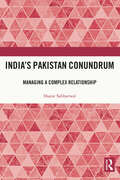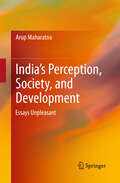- Table View
- List View
Indians, Markets, and Rainforests: Theoretical, Comparative, and Quantitative Explorations in the Neotropics
by Ricardo GodoyThis book addresses two important and related questions: does participation in a market economy help or hurt indigenous peoples and how does it affect the conservation of tropical rainforest flora and fauna? Oddly, there have been few quantitative studies that have addressed these issues.Ricardo Godoy's research takes an important step toward rectifying this oversight by investigating five different lowland Amerindian societies of tropical Latin America—all of which are experiencing deep changes as they modernize. Godoy examines the effect of markets on a broad range of areas including health, conservation of flora and fauna, leisure, folk knowledge, reciprocity, and private time preference. He concludes that, contrary to considerable anthropological theory, the effect of markets on the quality of life and the rainforest are often unclear or benign. Godoy uses multivariate techniques to examine the changes modernization has had on many indicators of the quality of life and the environment and concludes that the seeds of socioeconomic differentiation may already lie dormant in simple economies.The impact of modernization on lowland Amerindians is a topic of great concern to anthropologists, researchers, and policymakers in developing nations, and this book is a significant contribution to the debate about the likely future of indigenous people.
India–Africa Relations: Changing Horizons
by Rajiv BhatiaThis book explores the emergence and assertion of Africa as a significant actor and stakeholder in global affairs and the transformation of the India–Africa relationship. Beginning from this strategic perspective, the book presents an in-depth exploration of India–Africa partnership in all its critical dimensions. It delineates the historical backdrop and shared colonial past to focus on and contextualise the evolution of the India–Africa engagement in the first two decades of the 21st century. The book scrutinises the unfolding international competition in Africa in depth, which includes global actors such as the EU, US, and Japan, among others, focusing especially on China's growing influence in the region. Further, it dissects objectively the continental, regional and bilateral facets of India–Africa relations and offers a roadmap to strengthen and deepen the relationship in the coming decade. This volume will be very useful for students and researchers working in the field of international relations, foreign policy, governance, geopolitics, and diplomacy.
India–Bangladesh Border Disputes: History And Post-lba Dynamics (South Asia Economic and Policy Studies)
by Amit RanjanThis book discusses history of mental construction of the border between India and Bangladesh. It investigates how and when a border was constructed between the people, and discusses how the mental construction preceded the physical construction. It also examines the perils faced by those forced to leave their homes as a result of the partition of India in 1947. Globally throughout history, the absence of borders made the movement of people from one place to another easier. The construction of borders and sovereign de-limitation of territory restricted or even prevented seamless migration. The situation becomes more complex near borders that were previously open to the movement of people. One such border is between India and Bangladesh, where, in August 1947, suddenly people were told that the places they used to visit on a daily basis were now a part of a different sovereign country. This book argues that borders construct the identity of an individual or a group. Those who cross to the other side of border, for whatever reason, are identified and categorized by the state and the people. Sometimes these migrants face violence from the locals because they are considered a threat to the local working class. The book also explains how, after the liberation of Bangladesh in 1971, everyday encounter between people from India and Bangladesh have further embedded a feeling of us versus them. In 2015, India and Bangladesh agreed to implement the India–Bangladesh Land Border Agreement (LBA). This book assesses whether the implementation of this agreement will have impacts on border-related problems like mobility, migration, and tensions. It is a valuable resource for policymakers, journalists, researchers and students.
India–Vietnam Relations: Development Dynamics and Strategic Alignment (Dynamics of Asian Development)
by Reena Marwah Lê Thị Hằng NgaThis book provides an in-depth analysis of the close cultural links between India and Vietnam. It discusses the issues of trade negotiations under the Regional Comprehensive Economic Partnership (RCEP) and the Indo-Pacific construct. Issues such as strengthening the economic partnership, contemporary development challenges posed by the COVID-19 pandemic, including weakening supply chains, and geo-strategic tensions are explored in this book. It enriches understanding of the potential of the two countries to develop as manufacturing hubs for the region and beyond. Given the more aggressive posturing by China in 2020, the concluding chapter includes the policy prescriptions with a futuristic vision, for India and Vietnam to catalyze their strategic and bilateral partnership. Well researched and analytical, the book draws extensively from several interviews of experts, diplomats, journalists, businesspersons, and members of the diaspora. It is a must read for students, researchers, think tanks, area study centers, and all institutions engaged in Asian studies, encompassing narratives extending from the developmental to political, from the bilateral to the multilateral and from the geo-economic to the geo-strategic.
India’s Approach to Development Cooperation (Routledge Contemporary South Asia Series)
by Sachin Chaturvedi Anthea MulakalaIndia is emerging as a key player in the development cooperation arena, not only because of the increasing volume and reach of its south-south cooperation but more so because of its leadership and advocacy for the development of a distinctly southern development discourse and knowledge generation. This book traces and analyses the evolution of Indian development cooperation. It highlights its significance both to global development and as an effective tool of Indian foreign policy. Focussing on how India has played an important role in supporting development efforts of partner countries in South Asia and beyond through its various initiatives in the realm of development cooperation, the book tracks the evolution, genesis, and the challenges India faces in the current international context. The contributions provide a rich mix of academic and government, policy and practice, Indian and external perspectives. Theory is complemented with empirical research, and case studies on countries and sectors as well as comparisons with other aid providing countries are presented. The book is of interest to researchers and policy makers in the field of development cooperation, the role of emerging powers from the South, international development, foreign policy and global political economy.
India’s Biennale Effect: A politics of contemporary art
by Sunil Manghani Robert E. D'SouzaIndia’s Kochi-Muziris Biennale has been described as one of the most significant newly emergent biennales, alongside Shanghai, Sharjah and Dakar. However, there have been few sustained and critical studies of these events as specific sites of production and reception of contemporary art. This book, engaging with the Kochi Biennale, provides detailed examination of what the editors term as the ‘biennale effect’ — a layered contestation of place, economics, art and politics. It presents a close reading of the unique context of the biennale as well as sets out a broader critical framework for understanding global contemporary art and its effects. Replete with illustrations, this book will serve as an important and rare resource for scholars and researchers of contemporary art, art history, visual cultures, and media studies.
India’s Contemporary Urban Conundrum
by Sujata Patel Omita GoyalThis book lays out the different and complex dimensions of urbanisation in India. It brings together contributors with expertise in fields as varied as demography, geography, economics, political science, sociology, anthropology, architecture, planning and land use, environmental sciences, creative writing, filmmaking and grassroots activism to reflect on and examine India’s urban experience. It discusses various dimensions of city life—how to define the urban; the conditions generating work, living and (in)security; the nature of contemporary cities; the dilemmas of creating and executing urban policy, planning and governance; and the issues concerning ecology and environment. The volume also articulates and evaluates the way Indian urbanism promotes and organises aspirations and utopias of the people, whilst simultaneously endorsing disparities, depravities and conflicts. The volume includes interventions that shape contemporary debates. Comprehensive, accessible and topical, it will be useful to scholars and researchers of urban studies, urban sociology, development studies, public policy, economics, political studies, gender studies, city studies, planning and governance. It will also interest practitioners, think tanks and NGOs working on urban issues.
India’s Cybersecurity Policy: Evolution and Trend Analyses
by Thangjam K. SinghThis book examines India’s public policies on cybersecurity and their evolution over the past few decades. It shows how threats and vulnerabilities in the domain have forced nation-states to introduce new policies to protect digital ecosystems. It charts the process of securitisation of cyberspace by the international system from the end of the 20th century to the present day. It also explores how the domain has become of strategic interest for many states and the international bodies which eventually developed norms and policies to secure the domain.Consequently, the book discusses the evolution of cybersecurity policy at global level by great powers, middle powers, and states of concern and compares them with the Indian context. It also highlights the requirement of introducing/improving new cybersecurity guidelines to efficiently deal with emerging technologies such as 5G, Artificial Intelligence (AI), Big Data (BD), Blockchain, Internet of Things (IoT), and cryptocurrency.The book will be of great interest to scholars and researchers of cybersecurity, public policy, politics, and South Asian studies.
India’s Economic Corridor Initiatives: INSTC and Chabahar Port (Routledge Studies in the Growth Economies of Asia)
by Kashif Hasan KhanIndia’s Economic Corridor Initiatives highlights key aspects of current discourses on India’s initiative of the International North-South Transport Corridor (INSTC) and Chabahar, and their geo-economic significance.INSTC was founded by India, Russia, and Iran, and the Chabahar port in Iran provides a major prospective conduit for India's interchange and commerce with West Central Asia while maintaining a strategic distance from Pakistan's entry route. This book analyses the drastic changes in the equation of international relations in general, and more particularly between India and Eurasian countries. Contributors from Iran, Central Asia, Russia, Armenia and Europe provide a wide spectrum of opinion and analysis on the subject. The chapters claim that these corridors provide an alternative to the BRI and can play a pivotal role in de-escalating tensions through negotiations.A new addition to the debate on contemporary dynamics in Eurasia and India, this book will be of interest to researchers studying economic corridors, transnational and trans-regional economic relationships, security studies, regional and area studies, international relations and Indo-Iran-Russia relations.
India’s Economy and Society: Lateral Explorations (India Studies in Business and Economics)
by Sunil Mani Chidambaran G. IyerThis book is a collection of fifteen contributions that undertake a detailed analysis of seven broad dimensions of India’s economy and society. All the contributions approach the problems in their respective areas empirically, while being theoretically informed. The book begins with a section containing detailed and empirically supported chapters on the recent crisis in India’s agricultural sector and the reforms in the agricultural markets. Another section is dedicated to the issue of infrastructure financing, and new ways of financing large infrastructural projects are critically examined. Other sections are related to innovations and technology impacts on industry; international trade; health and education; labor and employment; and the very important issue of gender. The selected discussion topics are both of contemporary importance and expected to remain so for some time. Most of the chapters introduce readers to data in addition to methods of analyzing this data, to arrive at policy-oriented conclusions. The rich collection carries learnings for researchers working on a wide range of topics related to development studies, as well as for policymakers and corporate watchers.
India’s Energy Revolution: Insights into the Becoming of a Global Power
by Annika Bose StyczynskiIndia is the third-largest emitter of greenhouse gases, which makes it an important player whose climate mitigation actions and inactions are closely scrutinised. This book studies developments in India’s energy system from a governance perspective. It presents a unique compilation and synthesis of research findings that capture achievements, shortcomings, and persistent and transient challenges of India’s transition towards a net-zero economy by 2070.The book grounds its analysis in domestically formulated goals and reflects on dynamics at the structural level of India’s multi-scalar innovation system, by highlighting the influencing factors of energy system status and change. It presents the perspectives and positions of different actor groups, studies the market and business, and discusses cases influenced by existing or changing institutions across the whole spectrum of energy resources from fossil to non-fossil fuels and respective technologies.The volume will be useful for students and researchers in energy governance, energy policy and economics, socio-technical transition studies, energy systems engineering, sustainable development, and environmental studies. It will also be of interest to policymakers and investors.
India’s Freedom Struggle and the Urdu Poetry: Awakening
by Gopi Chand NarangPoetry, mainly Urdu poetry, played a very significant role in India’s freedom struggle. This book explores the poetic contributions going back centuries of colonial rule, which became songs of freedom and captured both the poignancy and fervor of revolution, protest, and hope. Urdu became one of the essential languages in colonial India, used by both political leaders and many young revolutionaries in speeches and writings as slogans for freedom and a call to action. Poets such as Josh Malihabadi, Firaq Gorakhpuri, Sahir, Makhdoom, Kaifi Azmi, Majaz, Majrooh, and Faiz Ahmad Faiz wrote highly patriotic poetry which was used not only to inspire and help mobilize people but also to offer criticism of existing socio-cultural practices in India and promote reform and equality. This work – a creative and selective translation of the book Hindustan Ki Tahriik-e Aazadi aur Urdu Shaa’yiri by Professor Gopi Chand Narang – includes English translations of poems from rare historical manuscripts as well as banned and witnessed poetry confiscated by the British. It looks at key events in India’s struggle for freedom through the prism of literature, language, poetry, and culture while also delving into the lives of poets who became the voice of their generation. This book is an essential read for students and researchers of colonial and postcolonial literature, cultural studies, comparative studies, history, and South Asian literature and culture.
India’s Grand Strategy and Foreign Policy: Strategic Pluralism and Subcultures (Routledge Advances in South Asian Studies #39)
by Bernhard Beitelmair-BeriniThe book explores the competing grand strategic worldviews shaping India’s foreign and security policies by analyzing the interaction between normative modern international relations theories and vernacular concepts of statecraft and strategy. To assess the diverse competing ideas which characterize India’s debates on grand strategy and foreign policy, the author presents the subculture-cleavage model of grand strategic thought. This innovative analytical framework reveals the complexities of India’s strategic pluralism and offers the building blocks for a systematic analysis of grand strategy formation. The book demonstrates that the strategic paradigms, or strategic subcultures, are marked by contending ideas of Indian statehood and civilization, held by policymakers and the informed public, and are a result of ideology-driven perceptions of the country’s strategic environment. The author argues that the apparent hybridization and stretching of modern and traditional concepts of international relations in India has become a widespread feature of Indian foreign policy to meet the needs of state formation and nation-building. A unique approach to organizing and understanding the debates and discourse in Indian strategic thinking, the book will be of interest to specialists and students in the field of International Relations, political theory, South Asian Studies, and India’s foreign and security policy.
India’s Grand Strategy: History, Theory, Cases (War and International Politics in South Asia)
by Kanti Bajpai Saira Basit V. KrishnappaAs India prepares to take its place in shaping the course of an ‘Asian century’, there are increasing debates about its ‘grand strategy’ and its role in a future world order. This timely and topical book presents a range of historical and contemporary interpretations and case studies on the theme. Drawing upon rich and diverse narratives that have informed India’s strategic discourse, security and foreign policy, it charts a new agenda for strategic thinking on postcolonial India from a non-Western perspective. Comprehensive and insightful, the work will prove indispensable to those in defence and strategic studies, foreign policy, political science, and modern Indian history. It will also interest policy-makers, think-tanks and diplomats.
India’s Great Power Politics: Managing China’s Rise
by Jo Inge Bekkevold; S. KalyanaramanThis book examines India’s foreign and defence policy changes in response to China’s growing economic and military power and increased footprint across the Indo-Pacific. It further explores India’s role in the rivalry between China and the United States. The book looks at the strategic importance of the Indian Ocean Region in the Indo-Pacific geopolitical landscape and how India is managing China’s rise by combining economic cooperation with a wide set of balancing strategies. The authors in this book critically analyse the various tools of Indian foreign policy, including defence posture, security alignments, and soft power diplomacy, among others, and discuss the future trajectory of India’s foreign policy and the factors which will determine the balance of power in the region and the potential risks involved. The book provides detailed insights into the multifaceted and complex relationship between India and China and will be of great interest to researchers and students of international relations, Asian studies, political science, and economics. It will also be useful for policymakers, journalists, and think tanks interested in the India–China relationship.
India’s Himalayan Frontiers: History and Politics (Nepal and Himalayan Studies)
by Viney C. BhutaniThis book looks at the historical and political dynamics of the Sino-Indian border dispute in India’s Himalayan Frontiers. Going back into Tibetan history, the author examines the making of the McMahon Line at Simla Conference of 1913–14. It also takes a look at some of the neighbouring areas that had interaction with Tibet, as well as the border areas of Assam and Burma, both of which were British Indian provinces. By using new archival materials, this study further goes to consider the events during the years following the defining of the McMahon Line, which, verily, did not have a sound juridical basis even if it has been regarded by scholars as a suitable boundary. It further explores different aspects of the northern frontiers of India and Sino-Indian border dispute and relations. This volume will interest scholars and researchers of history, political science and area studies, especially those interested in the geopolitics of India, China and the Himalayan region.
India’s Industrial Policy and Performance: Growth, Competition and Competitiveness
by Nitya NandaThis book assesses the performance of Indian industries from the perspectives of trade, investment, policy, and development incentives. It evaluates the relevance and the macro and microeconomic impact of industrial policy on growth in different sectors of industry. The book examines India’s key policy initiatives and economic and institutional plans through many decades and examines its short and long-term effects on industrial environment and performance. It measures India’s strategic policies and efforts to promote industrialization against similar initiatives in countries like Germany, Japan, South Korea and Taiwan. The volume also contextualises the performance of different sectors of industry in like automobiles, electronics and technology, and manufacturing, among others, within the larger framework of global economic scenario and competition. This book will be of great interest to researchers and students of economics, political economy, industrial development and policy, and South Asia studies.
India’s Maritime Strategy: Balancing Regional Ambitions and China (Politics in Asia)
by Shishir UpadhyayaThe first book by a former Indian naval intelligence officer on Sino-India relations, India’s Maritime Strategy provides a unique insight into the Indian Navy, tracing its post-independence growth and discussing its transformation and future in the 21st century. In the context of the rise of China’s maritime power in the Indian Ocean, this book provides a nuanced view of the extent and scope of India’s maritime reach and the effect of this on Sino-Indian competition. Challenging the view that by developing a favourable environment alone, India could seek to maintain its balance of power with China, it is argued that despite durable bilateral security ties with most regional states, India’s maritime aspirations to be the primary net security provider for the region are unsustainable in the long term. This book presents a comprehensive coverage of India’s bilateral maritime security engagements with all the Indian Ocean regional states, as well as the US, France, UK and Russia. As such, it will be useful to students and scholars of Indian and South Asian politics, international relations and maritime security.
India’s Mental Healthcare Act, 2017: Building Laws, Protecting Rights
by Brendan D. Kelly Richard M. DuffyThis book comprehensively discusses the background to the passing of India's revolutionary Mental Healthcare Act, 2017, offering a detailed description of the Act itself and a rigorous analysis in the context of the CRPD and the World Health Organization (WHO) standards for mental health law. It examines the fine balance, between complying with the CRPD while still delivering practical, humane, and implementable legislation. It explores how this legislation was shaped by the WHO standards and provides insights into areas where the Indian legislators deviated from these guidelines and why. Taking India as an example, it highlights what is possible in other low- and middle-income countries. Further it covers key issues in mental health, identifying potential competing interests and exploring the difficulties and limitations of international guidelines.The book is a valuable resource for psychiatrists, nurses, social workers, non-governmental organizations and all mental healthcare workers in India and anyone studying human rights law.
India’s National Security: Annual Review 2012
by Satish KumarThe twelfth volume in the series India’s National Security: Annual Review offers a detailed analysis of India’s complex security environment: persistence of major threats, alongside a constructive engagement with major powers based on its economic growth, military power and political stability. Topping the list of India’s external security concerns is China’s veiled hostility, manifest in its strategic nexus with Pakistan, incursions into India’s borders and enhanced military deployment in India’s immediate neighbourhood. Added to these are the intractable boundary dispute and uncertain implications of the recent leadership change in China. India, nevertheless, is attempting to cope with China’s pressures by engaging with it at a diplomatic level and improving its own defence capability. Pakistan remains another major threat, because of its refusal to take action against militants responsible for the 2008 Mumbai terror attacks, its efforts at expanding its nuclear arsenal, and the increasing sway of right-wing elements on its society, politics and security forces. India further faces the challenges of facilitating Nepal’s difficult transition to democracy, safeguarding its strategic interests in Afghanistan, stabilising Maldives’ fledgling democracy, and tackling ethnic insurgencies along its borders with Myanmar. On the other hand, there are positives like India’s strategic partnerships with Russia, US, France, Britain, Germany, and Japan, as well as a flowering relationship with Bangladesh. India’s internal security situation is less alarming, with progress in talks with some North-Eastern insurgent outfits; a sharp fall in casualties due to left-wing extremism (LWE); and a gradual reduction in terrorist-related incidents in Kashmir. But sporadic cross-border infiltrations in Kashmir and spread of LWE to urban areas still pose challenges. Addressing such and other issues, this book will be indispensable for policymakers and governmental organisations; those in defence and strategic sectors; and students of defence studies, foreign policy, international relations, and political science.
India’s Nonviolent Freedom Struggle: The Thomas Christians (1599–1799) (Routledge Studies in South Asian History)
by Clara A. JosephIndia’s Nonviolent Freedom Struggle focuses on the Thomas Christians, a group of Christians in South India who waged a nonviolent struggle against European colonization during the politically volatile period of 1599-1799. This book has three related objectives and unique characteristics. First, it offers a comprehensive study of primary sources that scholars have referenced but rarely studied in-depth. Second, it argues that the Thomas Christian narratives provide a unique position to challenge prevalent estimations found in canonical and postcolonial critical discourse on the nation. Third, it considers how an account of a nonviolent struggle by Thomas Christians further complicates received ideas of the postcolonial nation. It sheds light on the often-overlooked contributions of the Thomas Christians in India’s nonviolent freedom struggle and challenges readers to reimagine the complex and often contentious relationship between colonizers and colonized. A groundbreaking book that offers a fresh perspective on the Indian freedom struggle and the study of Indian history, this book is an essential read for scholars of colonialism, anticolonial movements, and the history of India.
India’s Pakistan Conundrum: Managing a Complex Relationship
by Sharat SabharwalHistorically, the relationship between India and Pakistan has been mired in conflicts, war, and lack of trust. Pakistan has continued to loom large on India’s horizon despite the growing gap between the two countries. This book examines the nature of the Pakistani state, its internal dynamics, and its impact on India. The text looks at key issues of the India-Pakistan relationship, appraises a range of India’s policy options to address the Pakistan conundrum, and proposes a way forward for India’s Pakistan policy. Drawing on the author’s experience of two diplomatic stints in Pakistan, including as the High Commissioner of India, the book offers a unique insider’s perspective on this critical relationship. A crucial intervention in diplomatic history and the analysis of India’s Pakistan policy, the book will be of as much interest to the general reader as to scholars and researchers of foreign policy, strategic studies, international relations, South Asia studies, diplomacy, and political science.
India’s Perception, Society, and Development: Essays Unpleasant
by Arup MaharatnaThere has been, of late, a growing realisation that the pace and pattern of economic development of a country can hardly be understood and explained comprehensively in terms of the straitjacket of economics discipline alone. India is a prime example of the importance of the part played by a country's history, culture, sociology, and socio-cultural-religious norms, values, and institutions in its development process. This book, with its assorted essays of varying depths of scholarship and insightful reflections, attempts to drive home this point more forcefully than ever before. In its search for the non-economic roots of India's overall sloth and murky progress in its broad-based economic and human development, the book illuminates major oddities deep inside a unique mental make-up full of perceptual and ideational dilemmas, many of which are arguably shaped by the long-lasting and dominant influence of what could be called the Brahminical lines of thinking and discourse. With India's hazy and dodgy world of perceptions as a backdrop, the book also addresses - through its intelligent essays - the deep and sometimes dire ramifications of the historic advent and the dramatic advance of neoliberal market ideology today.
India’s Private Health Care Delivery: Critique and Remedies
by Sanjeev KelkarThis book brings together all the major components of the private health care sector in India, with detailed description of its evolution, the foundational ideas, its development, the positives and ill effects on the population. It suggests intelligible and practical remedies for public good. The book presents a comprehensive review of private health care sector’s resistance to Indian Government’s reforms like the national medical commission, NEET, clinical establishment act and the new boost to the traditional medicine by the Indian government. The author has discussed contentious areas like Corporate Hospitals, Capitation Fee Colleges, Pharmaceutical Industry, Western Models in Health Care, Integration of Medical Systems, Ayushman Bharat Scheme, Health Insurance and Public Private Partnership on a massive scale.
India’s Relations with Neighboring South and South East Asian Countries: Perspectives on Look East to Act East Policy (Dynamics of Asian Development)
by Lipi Ghosh Anasua Basu Ray ChaudhuryThis book presents a holistic perspective across various facets of culture, history, politics, economics and strategy in India’s relations with neighbouring South and Southeast Asian countries. This book not only analyses various issues of India’s foreign policy diplomacy but also explores the perspectives of neighbouring countries towards India. It engages experts from India and its South and Southeast Asian neighbours to discuss topics, such as overland linkages, people-to-people interactions, opportunities and implications of India’s Act East policy on its neighbours in changing geopolitical backdrop. The book emphasises on the responses to the COVID-19 pandemic and suggests a greater scope of regional cooperation on emergencies such as health crises in the Bay region. This rich collection of essays has strategic and scholarly relevance for researchers working on a wide range of topics related to development studies, cultural studies, Asian studies as well as policy makers and general readers.

